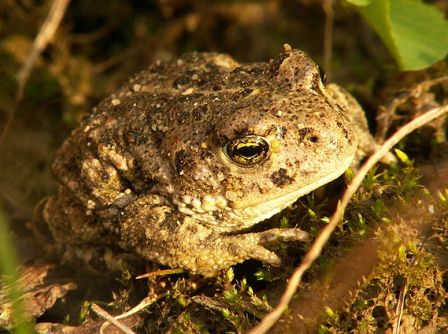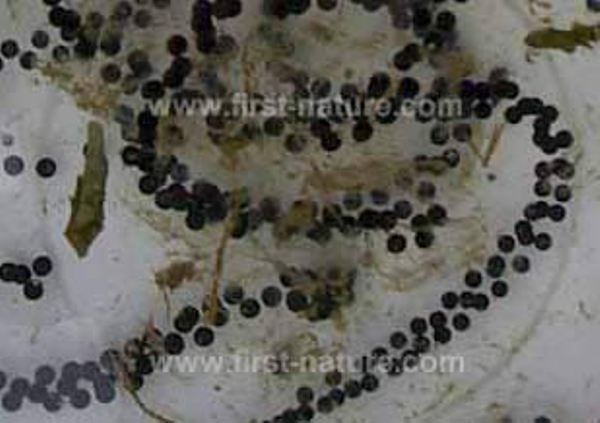Epidalea calamita - Natterjack Toad
Phylum: Chordata - Class: Amphibia - Order: Anura - Family: Bufonidae
Identification - Distribution - Lifecycle - Food - Predators - Reference Sources

At 6 to 7cm long when fully grown, the Natterjack Toad is slightly smaller than the more familiar and much more widespread Common Toad. The Natterjack gets its common name from the loud rasping sound made by the male as it sits at night on the edge of a brackish lagoon or an ephemeral freshwater pool hoping to attract a mate during the breeding season.
This endangered species is one of the rarest of amphibians in Britain, and its numbers have declined markedly in recent times. A reintroduction programme has resulted in a few new colonies being set up in parts of England, but it is unclear whether many of these have the potential to become self sustaining.
The specific epithet calamita is a reference to the way the Natterjack Toad moves around. Rather than hopping like a frog or crawling ponderously like a Common Toad, it runs.
Identification
A thin yellow line down the middle of its back distinguishes the Natterjack Toad from the somewhat larger Common Toad. There are other differences, too: the legs of this toad are shorter than those of the Common Toad. There is also a very obvious audible difference: male Natterjack Toads are extremely vocal during the mating season, and to attract the attention of potential mates they make loud rasping calls starting at dusk and continuing for many hours into the night.
Distribution
Populations of Natterjack Toads occur in Wales, England and Scotland and in one or two places in southern Ireland; their natural distribution in Britain, which is close to the northern limit of their range, is almost entirely confined to sandy coastal dunes, where shallow, slowly-shelving pools provide suitably warm spawning habitat. (Natterjacks don't usually breed successfully in cold water, although surprisingly a colony is known to survive in an upland fell site in Cumbria, where it is unlikely that there are many shallow pools of freshwater as warm as those found in coastal dune slacks.) Elsewhere in Europe, Natterjack Toads can be found from the southern part of Scandinavia right down to the western Mediterranean and the Iberian Peninsula, and in warm southern countries these amphibians are found in many inland sites as well as in some coastal areas.
Conservation
Natterjack Toads are protected by British and European law which makes it an offence to kill, injure, capture or disturb them or to damage or destroy their habitat. If these toads move in to your garden pond, enjoy their company by alll means, but be aware that it is illegal to sell them or to give them to a friend or a neighbour. (These rules apply not only to adult Natterjack Toads but also to their spawn and larval stages.)
Food
Natterjack toadlets feed on ants and other tiny insects. Adults are known to eat larger insects such as moths and woodlice as well as spiders, slugs, worms and other invertebrates, but in sand dune systems small crustaceans such as freshwater shrimps and sandhoppers are likely to feature in their diets too. A toad's tongue is sticky, and once 'flicked and licked' their hapless victim has little chance of escape. Natterjack toads often feed close to or even from the entrance of their daytime hideaways, usually shallow excavated burrows but sometimes natural 'caves' beneath driftwood or fallen timber. They are capable of running fast enough to outpace and so get within tongue-shooting range of their prey.
Predators
Toads secrete an irritant from their skin, and as a result few predators want to eat more than one of them! There are exceptions, however: grass snakes are able to eat Natterjack Toads without apparently suffering any discomfort from toxic secretions. Some birds including Magpies, Rooks and Grey Herons are also able to cope with the toxins secreted from the skins of toads.
Lifecycle
Natterjacks mate at night in shallow pools, often only temporary in nature and drying out in late summer. Their main mating season in Britain is April and May, but sometimes they can be seen mating as late as August..
Female toads instinctively try to return to the lake or pond in which they were born. During the breeding season a female Natterjack Toad can lay up to 7500 eggs, although 3000 to 4000 is probably more typical. It takes only 7 to 10 days for the eggs to hatch into tadpoles, which are very similar to those of frogs but with rounder, darker heads and shorter tails. The tadpoles become toadlets over a period of about 6 to 8 weeks, losing the tail as they develop first their forelegs and then their hindlegs. Toadlets emerge from their natal ponds in mid to late summer.

The ribbon-like spawn of a toad is easily distinguished from the 'tapioca pudding' form of frog spawn; however, it's not quite so easy to tell whether a ribbon came from a Common Toad or its slightly smaller relative the Natterjack Toad. If you look closely you will see that a Common Toad lays spawn that remains in a double row (seen here), whereas although initially in the form of two parallel ribons the Natterjack's spawn soon separates into more widely and irregularly spaced single-file ribbons.
By far the easiest way to tell Natterjack spawn from Common Toad spawn is to wait and see what kind of toadlets develop. (In the UK Natterjack Toads are most unlikely to appear in your garden pond unless you live right beside the sea, so habitat is also a helpful clue.)
Like the Common Toad, Natterjack Toads hibernate in burrows during the winter months, usually emerging some time in late March or in April.
Age range
With their warty, wrinkled skin toads always look old, and some of them certainly are: if they can avoid being run down by road vehicles and keep out of the way of their natural predators, toads can live to a ripe old age - up to 40 years.
Reference Sources
Matching the Hatch by Pat O'Reilly (2017) - learn all about aquatic insects and other small water creatures that feature in the diet of toads.
Please Help Us: If you have found this information interesting and useful, please consider helping to keep First Nature online by making a small donation towards the web hosting and internet costs.
Any donations over and above the essential running costs will help support the conservation work of Plantlife, the Rivers Trust and charitable botanic gardens - as do author royalties and publisher proceeds from books by Pat and Sue.

